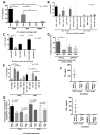Neuroblastoma killing properties of Vδ2 and Vδ2-negative γδT cells following expansion by artificial antigen-presenting cells
- PMID: 24893631
- PMCID: PMC4445920
- DOI: 10.1158/1078-0432.CCR-13-3464
Neuroblastoma killing properties of Vδ2 and Vδ2-negative γδT cells following expansion by artificial antigen-presenting cells
Abstract
Purpose: The majority of circulating human γδT lymphocytes are of the Vγ9Vδ2 lineage, and have T-cell receptor (TCR) specificity for nonpeptide phosphoantigens. Previous attempts to stimulate and expand these cells have therefore focused on stimulation using ligands of the Vγ9Vδ2 receptor, whereas relatively little is known about variant blood γδT subsets and their potential role in cancer immunotherapy.
Experimental design: To expand the full repertoire of γδT without bias toward specific TCRs, we made use of artificial antigen-presenting cells loaded with an anti γδTCR antibody that promoted unbiased expansion of the γδT repertoire. Expanded cells from adult blood donors were sorted into 3 populations expressing respectively Vδ2 TCR chains (Vδ2(+)), Vδ1 chains (Vδ1(+)), and TCR of other δ chain subtypes (Vδ1(neg)Vδ2(neg)).
Results: Both freshly isolated and expanded cells showed heterogeneity of differentiation markers, with a less differentiated phenotype in the Vδ1 and Vδ1(neg)Vδ2(neg) populations. Expanded cells were largely of an effector memory phenotype, although there were higher numbers of less differentiated cells in the Vδ1(+) and Vδ1(neg)Vδ2(neg) populations. Using neuroblastoma tumor cells and the anti-GD2 therapeutic mAb ch14.18 as a model system, all three populations showed clinically relevant cytotoxicity. Although killing by expanded Vδ2 cells was predominantly antibody dependent and proportionate to upregulated CD16, Vδ1 cells killed by antibody-independent mechanisms.
Conclusions: In conclusion, we have demonstrated that polyclonal-expanded populations of γδT cells are capable of both antibody-dependent and -independent effector functions in neuroblastoma.
©2014 American Association for Cancer Research.
Figures






Comment in
-
Promising cell-based immunotherapy using gamma delta T cells: together is better.Clin Cancer Res. 2014 Nov 15;20(22):5573-5. doi: 10.1158/1078-0432.CCR-14-1371. Epub 2014 Oct 2. Clin Cancer Res. 2014. PMID: 25278452
References
-
- Himoudi N, Morgenstern DA, Yan M, Vernay B, Saraiva L, Wu Y, et al. Human γδT Lymphocytes Are Licensed for Professional Antigen Presentation by Interaction with Opsonized Target Cells. The Journal of Immunology. 2012;188:1708–16. - PubMed
-
- Gertner-Dardenne J, Bonnafous C, Bezombes C, Capietto AH, Scaglione V, Ingoure S, et al. Bromohydrin pyrophosphate enhances antibody-dependent cell-mediated cytotoxicity induced by therapeutic antibodies. Blood. 2009;113:4875–84. - PubMed
-
- Brandes M, Willimann K, Moser B. Professional antigen-presentation function by human gammadelta T Cells. Science. 2005;309:264–8. - PubMed
-
- Wu Y, Wu W, Wong WM, Ward E, Thrasher AJ, Goldblatt D, et al. Human γδ T Cells: A Lymphoid Lineage Cell Capable of Professional Phagocytosis. The Journal of Immunology. 2009;183:5622–9. - PubMed
Publication types
MeSH terms
Substances
Grants and funding
LinkOut - more resources
Full Text Sources
Other Literature Sources
Medical

